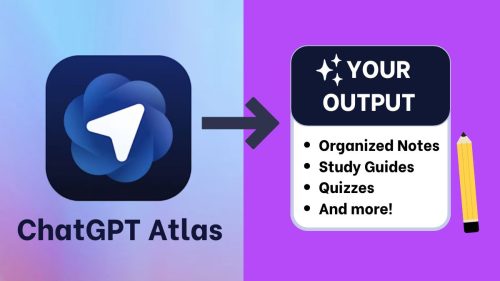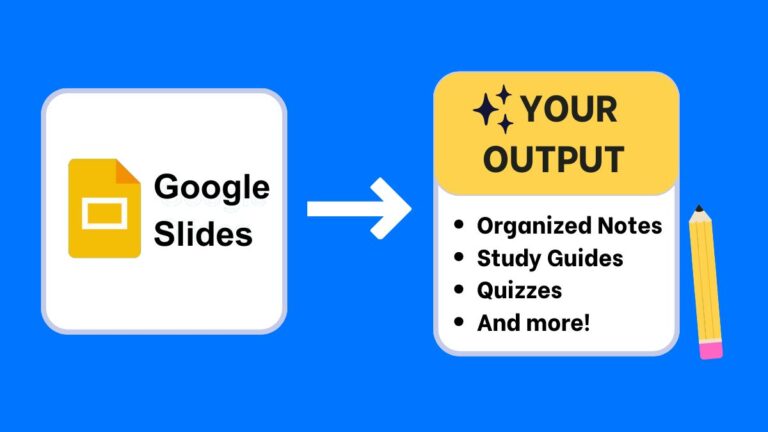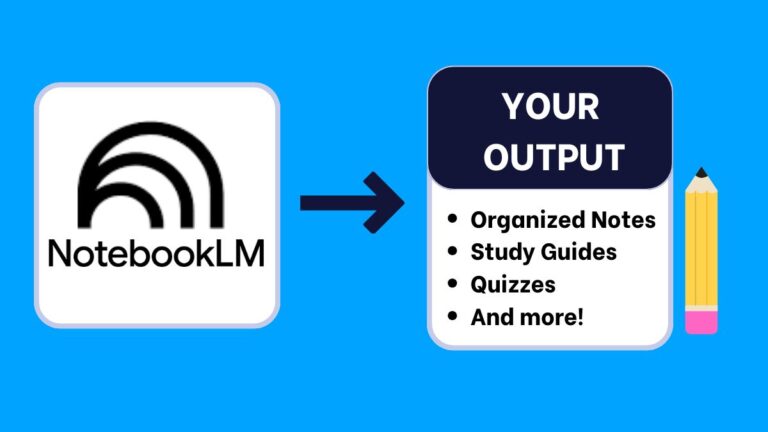Overview
AI note-taking with ChatGPT Atlas turns lectures, webpages, and PDFs into organized, study-ready notes for students and teachers. Open your source in Atlas, use the context-aware sidebar to outline content, extract key terms, and convert results into study assets: study guides, lesson plans, quizzes, Q&A banks, and flashcards. This guide gives copy-ready prompts and practical ChatGPT Atlas examples you can run today.
My AI Note-Taking ChatGPT Workflow
- Capture audio → get transcript (or upload audio directly to ChatGPT in the Atlas tab).
- Clean + structure into H2/H3 with bullets, summary, and glossary.
- Convert output to Study Guide, Lesson Plan, Q&A, Quiz, and Flashcards.
- Fact-check names, dates, formulas; tag uncertainties as
[verify]. - Export + schedule spaced review sessions.
Step 1 — Record & Transcribe Lecture
Goal: capture accurate inputs so Atlas produces reliable notes.
Checklist
- Follow school policy and obtain permission before recording.
- Record on your phone/laptop or export captions from Zoom, Google Meet, or YouTube.
- In the Atlas tab, upload audio to transcribe or paste an existing transcript.
Prompt I Use:
-
Clean this transcript and structure it for study: • Remove filler; fix casing and punctuation; keep technical terms. • Add H2 topics and H3 subtopics with 3–5 bullets each. • End with a 150–250 word executive summary and 6–12 key terms with one-line definitions. • Keep timestamps/slide numbers; tag uncertainties as [verify]. Transcript: [paste]
Step 2 — Organize Clean Notes
Goal: create skimmable sections that power every downstream asset.
I Ask ChatGPT to:
- Clean: remove filler; fix punctuation; keep domain terms.
- Structure: add H2 topics and H3 subtopics with 3–5 bullets each.
- Summarize: 150–250-word executive summary.
- Glossary: 6–12 key terms with one-line definitions and a common misconception.
- Flag: mark unclear items as [verify] and reference timestamps or slides.
Prompt I Use:
-
Organize these notes: clean filler, fix casing/punctuation, then format as H2 topics and H3 subtopics with 3–5 bullets each. Add a 150–250-word executive summary and a glossary of 6–12 terms with one-line definitions + 1 misconception each. Keep timestamps or slide numbers. Tag uncertainties as [verify]. Notes: [paste]
Step 3 — Create a Study Guide
Goal: turn structured notes into a timed review plan tied to exam weight.
Ask ChatGPT to:
- Group content into Concepts, Procedures, Cases/Readings, Formulas.
- Set learning objectives and build a 2-hour plan (4×25-min + 5-min breaks).
- Add checkpoints with expected answer length and exam priority.
- Finish with 10 must-knows and 5 pitfalls.
Prompt I Use:
-
From the structured notes below, build a study guide. 1) Buckets: Concepts, Procedures, Cases/Readings, Formulas. 2) Two learning objectives per bucket. 3) 2-hour schedule: four 25-minute focus blocks with 5-minute breaks. 4) Two checkpoints per bucket with expected answer length. 5) Tag High/Medium/Low exam priority. 6) End with 10 must-knows and 5 pitfalls. Notes: [paste]
Step 4 — Create a Lesson Plan
Goal: convert notes into a one-period plan with measurable outcomes.
Prompt I Use:
-
From my structured notes, create a one-period lesson plan. 1) Three objectives with measurable verbs. 2) Timed agenda: warm-up → direct instruction → guided practice → exit ticket. 3) Differentiation plus IEP/504 accommodations as appropriate. 4) Checks-for-understanding tied to objectives. 5) Materials list; keep total time within 60 minutes. Notes: [paste]
Step 5 — Build a Q&A Bank
Goal: progressive practice from recall to application.
Prompt I Use:
-
From my structured notes, build a progressive Q&A bank: • Level 1: recall (definitions, who/what/when) • Level 2: explain/compare (short rationales, step order) • Level 3: apply (novel scenarios or examples) Return 15–30 items with concise answers (≤40 words) and an H2/H3 reference for each. Notes: [paste]
Step 6 — Generate a Quiz
Goal: quick assessment with rationales and an answer key.
Prompt I Use:
-
From my structured notes, generate a mixed quiz: 1) 5 MCQs (1 correct + 3 plausible distractors) with a 1-sentence rationale. 2) 3 short-answer items with target response length and grading hints. 3) 2 show-your-work problems including units or formulas. Tag each item with the source H2/H3 and provide a printable answer key with optional difficulty (1–3). Notes: [paste]
Step 7 — Make Flashcards
Goal: fast recall for definitions, processes, and formulas.
Prompt I Use:
-
From my structured notes, create 25 flashcards for quick recall: • 10 definition cards (key terms and ideas) • 8 process cards (ordered steps) • 7 formula cards (use cloze deletions) Keep each answer ≤25 words, avoid duplicates, and format as Q: / A: lines. Notes: [paste]
Step 8 — Export, Review, and Spaced Practice
- Export final notes plus separate files for study guide, quiz, and flashcards.
- Version filenames:
Course-YYYY-MM-DD-v1. - Schedule 3–4 short spaced sessions before the exam; review starred items first.
Practical Atlas Use Cases
For Students
- STEM lecture → worked solutions: extract formulas, convert example problems to step-by-step solutions, then make 4 new practice problems with units.
- History reading → compare/contrast: outline causes vs. outcomes, add a 5-point timeline, then generate two short-answer prompts.
- Research article → summary + glossary: pull methods, variables, and a plain-language abstract; create 10 term cards.
For Teachers
- Unit kickoff: open the syllabus page in Atlas, auto-outline objectives, generate a one-period lesson plan and a parent update email.
- Quiz building: transform notes into 5 MCQs, 3 short-answer items, and 2 problem-solving questions with rationales and an answer key.
- Differentiation: create tiered practice sets (foundational, on-level, extension) from the same structured notes.
ChatGPT Copy-Ready Prompts
Use these ChatGPT AI note-taking prompts with Atlas to convert audio, webpages, and PDFs into clean, structured notes you can study or teach from.
Organize & Clean Notes
-
Act as my study assistant. CLEAN the transcript: remove filler, fix casing/punctuation, join broken lines. STRUCTURE with H2 topics and H3 subtopics; under each H3 add 3–5 bullets; tag unclear items as [verify]. End with a 200-word summary and 8 key terms with one-line definitions. Transcript: [paste]
Create a Study Guide
-
From the structured notes above, build a STUDY GUIDE with sections: Concepts, Procedures, Cases/Readings, Formulas. For each section: 2 learning objectives, 2 checkpoints (with expected answer length), and a time estimate to fit a 2-hour review block. Finish with 10 must-knows and 5 pitfalls.
Create a Lesson Plan
-
Turn the structured notes into a one-period LESSON PLAN: (1) objectives aligned to today’s content, (2) agenda with times (warm-up, direct instruction, guided practice, exit ticket), (3) differentiation for readiness and accommodations, (4) checks-for-understanding tied to objectives, (5) materials list). Keep total time within one class period.
Build a Q&A Bank
-
Create a Q&A BANK with 18 items: 6 recall, 6 explain/compare, 6 novel scenarios. Provide concise answers and reference the H2/H3 section each question maps to. Keep answers ≤40 words unless steps are required.
Generate a Quiz + Key
-
Generate a mixed QUIZ from the notes: 5 MCQ (1 correct + 3 plausible distractors), 3 short-answer (2–4 sentences), 2 show-your-work problems (include units). Provide an answer key. For each MCQ, include a 1-sentence rationale and tag the source section.
Make Flashcards
-
Create 25 FLASHCARDS: 10 definitions, 8 processes (step order), 7 formulas using cloze deletions. Keep answers ≤25 words. Avoid duplicates and flag near-synonyms. Format as Q: / A: lines.
AI Note-Taking FAQs
Can ChatGPT Atlas turn audio into notes directly?
Yes. Transcribe in ChatGPT within the Atlas tab or paste captions, then run the structure prompt.
Do I need permission to record?
Follow your institution’s policy and local law. When unsure, ask the instructor and obtain consent before recording.
How do I handle long lectures?
Process in 20–30 minute blocks or 2–3k-word chunks. Merge outputs, then generate a fresh summary and glossary.
How do I keep outputs accurate?
Tag [verify] items, cross-check proper nouns, dates, and formulas, and re-run only the affected sections.
What can I export?
Copy notes to Google Docs, export glossary/flashcards to CSV, or paste into your LMS. Version files for easy updates.
Conclusion
Open sources in Atlas, generate structured notes, then spin out a study guide, lesson plan, Q&A bank, quiz, and flashcards. Verify key details, export clean copies, and schedule spaced review. Explore our NotebookLM workflow next. For complete note-taking systems, see our AI Note Taking Hub and Best AI Note Takers.
Happy Atlas AI note taking!




